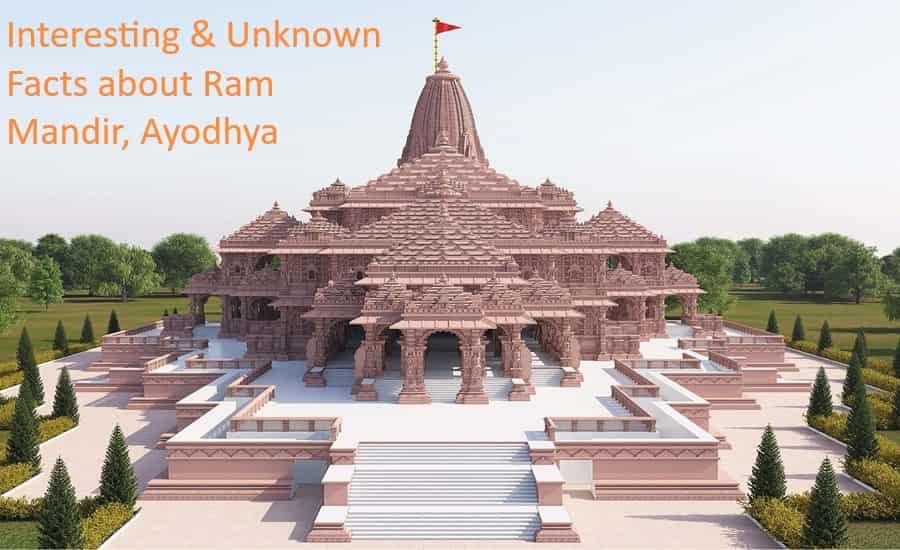Ayodhya Ram Mandir-Some Wonderful Facts-24
Ayodhya Ram Mandir
Ayodhya Ram Mandir -This temple built in the Nagara architectural style of ancient India. The majestic Ram Temple in Ayodhya is an exquisitely planned, scientifically constructed work of art.
This temple is 161 feet high, 235 feet wide and 360 feet long overall.
The built up area of the temple is approximately 57,000 square feet, spread over three floors. Qutub Minar is almost twice the height of the temple.
This temple is situated on 2.7 acres of land in the city. It is built in one of the two distinct temple-building traditions of ancient India:

Nagara, using a blend of contemporary technology and Vedic rites.
The temple is situated on a high platform, with a third storey shikhara or mountain peak rising over the most revered area of the building, known as the sanctum sanctorum or “Garbha Griha“.
Altogether five mandapas are used to construct five such shikharas. 44 teak doors have been installed, and there are 300 pillars in the pavilions.
The temple is being constructed, incorporating approximately two lakh bricks collected over thirty years and inscribed with the name of Lord Rama in multiple languages.
Follow Our Digiknowledge.co.in Page for Latest update about Bikes, Cars, Sports, , Life style and many more.
Makrana stone, which was also used in the construction of the Taj Mahal, was used to decorate the interior of the sanctum sanctorum.
Unique bricks are used in the construction, called “Ram Shilayans”, with the words “Shri Ram” engraved on them.
By creating a symbolic analogy between the bricks and stones used in the construction of Ram Setu, the contemporary workmanship of the temple and its historical significance have been linked.
Neither iron nor steel is used. Iron or steel is not often used in temple construction during the Gupta period, which gave rise to the Nagara style. Iron can live for about 80-90 years.
Assured to be up to 1,000 years old, the temple is constructed of granite, sandstone and marble, secured by a lock and key system.
It is noteworthy that neither mortar nor cement was used in its construction. Initially, 45 layers of engineered soil were laid in the area after digging to a depth of 15 meters to create a strong base.
A solid granite stone plinth of 6.3 m thickness was placed over a 1.5 m thick M-35 grade concrete raft to provide stability.
Several pillars provide major support for the foundation of the temple. 160 columns support the ground floor, and 132 columns support the first floor.
Seventy-four pillars support the second tier, which is decorated with elaborate details and designs. These pillars add balance and beauty to the temple.
One of the building materials is the Shaligram rock, a sacred fossil discovered in the Gandaki River of Nepal.
An additional spiritual element of the temple is the Shaligram, which is revered in Hinduism and is seen as a sign of Lord Vishnu.
Science and tradition in opposition
The famous Ram Temple is constructed with the assistance of some eminent Indian experts. ISRO technologies were also used in the construction. This initiative has been actively supported by Pradeep Kumar Ramanchrala, head of the Central Building Research Institute (CBRI).
A group of scientists from CBRI and the Indian Institute of Astrophysics (IIA) created a unique lens-based instrument known as the “Surya Tilak” mirror.
At noon on every Rama Navami day, when the sun shines on the forehead of the idol, it is used for the ceremonial consecration of Lord Rama.
The Ram Temple is intended to serve as a cultural center apart from its religious importance.
The presence of educational rooms and meditation areas shows a comprehensive approach to the temple’s function in promoting spiritual, cultural and educational endeavors.
Bansi Paharpur pink sandstone, which comes from Bharatpur district of Rajasthan, is used in the construction of the large temple.
The platforms made of granite stones give a strong and long lasting foundation to the temple.
Apart from increasing the overall lifespan of the temple, the use of granite strengthens its structure.
The exquisite inlay work is done using colored and white Makrana marble. According to Shri Ram Janmabhoomi Teerth Kshetra, an estimated ₹1,800 crore will be required to complete the architectural marvel.
A total of Rs 900 crore was claimed to be spent in the process of construction of Ram temple between 5 February 2020 and 31 March 2023.
What is the importance of Shree Ram?
In Indian culture and religion, Lord Ram is the most revered figure of them all. Ram is regarded as an example of the ideal human person and a symbol of justice and tenacity because of his bravery, loyalty, and dedication. For many, he represents sacrifice, loyalty, and morality.
Which river flows in Ayodhya?
The Saryu River , which is one of Uttar Pradesh’s most well-known streams, is mentioned in classic Hindu texts like the Ved and the Ramayan. The river that flows through Ayodhya, which means literally “that which is streaming,” is said to refresh the city and remove impurities.
Who is the first king of Ayodhya?
“The entire fertile earth was given by Manu to Ikshvaku and know that Ikshvaku was thus the first king of Ayodhya!”




